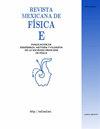量子HHL算法在电路和线路传输波中的应用
Q4 Social Sciences
引用次数: 0
摘要
HHL量子算法[1]是一种解决线性方程组(QLSP)分辨率问题的程序。在一定条件下,该算法在方程数量上具有对数阶,优于速度较快的经典方法。该算法设法找到一个与解向量成比例的量子态,直到归一化因子。缺点是,要确定解向量的每个系数,必须使用额外的统计方法来确定算法的输出量子态,从而失去其指数优势。在某些类型的问题中,这种缺点是可以避免的,统计处理是不可避免的,但对于某些情况,如电路,其中主要兴趣是只找到其中一个电流(例如负载电流),我们只需要测量解状态的量子位之一。在本文中,我们使用HHL算法,在Scilab数值环境中模拟了与正弦电压电路的电流相关的线性系统。文中还给出了在IBMQ平台上的一台实机中一个电力线传输波的优化实例本文章由计算机程序翻译,如有差异,请以英文原文为准。
Quantum HHL algorithm applied to electric circuit and line transmission wave
The HHL quantum algorithm [1] is a procedure that addresses the resolution of linear systems of equations (QLSP). Under certain conditions, the algorithm has a logarithmic order in the number of equations, better than the faster classical method. The algorithm manages to find a quantum state proportional to the solution vector, up to a normalization factor. The disadvantage is that to determine each of the coefficients of the solution vector, the algorithm’s output quantum state must be determined with additional statistical methods, thus losing its exponential advantage. There are certain types of problems in which this disadvantage can be circumvented, the statistical treatment is unavoidable, but for certain cases such as electrical circuits, in which the main interest is to find only one of the currents, (for example the load current), we only need to measure one of the qubits of the solution state. In this article we solve the linear system associated with the currents of an electrical circuit with sinusoidal voltage, using the HHL algorithm, simulated in a Scilab numerical environment. An optimized example of an electrical line transmission wave in a real computer on the IBMQ platform, is also solved
求助全文
通过发布文献求助,成功后即可免费获取论文全文。
去求助
来源期刊

Revista Mexicana De Fisica E
社会科学-科学史与科学哲学
CiteScore
0.80
自引率
0.00%
发文量
14
审稿时长
>12 weeks
期刊介绍:
The Revista Mexicana de Física (Rev. Mex. Fis.) publishes original papers of interest to our readers from the physical science com unity. Language may be English or Spanish, however, given the nature of our readers, English is recommended. Articles are classified as follows:
Research. Articles reporting original results in physical science.
Instrumentation. Articles reporting original contributions on design and construction of scientific instruments. They should present new instruments and techniques oriented to physical science problems solutions. They must also report measurements performed with the described instrument.
Reviews. Critical surveys of specific physical science topics in which recent published information is analyzed and discussed. They should be accessible to physics graduate students and non specialists, and provide valuable bibliography to the specialist.
Comments. Short papers (four pages maximum) that assess critically papers by others authors previously published in the Revista Mexicana de Física. A comment should state clearly to which paper it refers.
 求助内容:
求助内容: 应助结果提醒方式:
应助结果提醒方式:


